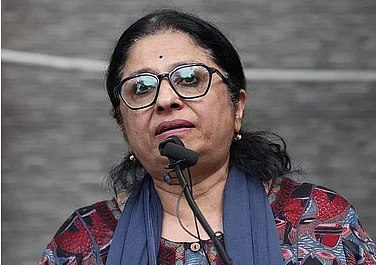In early 2019, I had gone to register my car papers at the motor vehicles office in Noida. As I stood waiting for a man to photocopy my documents, I became aware of the stares of people around me. This was, of course, nothing I was not used to, but these stares were slightly different, more uncomfortable, more in my face. I looked up and looked around slowly—all I could see were men, men, and more men. In that courtyard of easily a few hundred men, I was the only woman or at least the only one unaccompanied by a man. I took a picture of the courtyard and when I looked at it later, I was amazed. We often talk about women missing from our public spaces but to see it captured was a different feeling altogether.
Often, when I am in a car driven by a female friend, male drivers honk, try to corner the car—for them it’s a sport, to see us flustered and scared, to push us back into our homes. Ask any woman who drives, especially in North India, she will have a similar story to tell. I have never wandered through the streets like I often see men doing. My relationship with the streets is strictly functional, as I believe is the case with most other women. We try to go from point A to point B, getting our work done without grabbing too much attention.
*
In early February 2018, in a small room in Madanpur Khadar, a resettlement colony in the Indian capital, a group of young girls were discussing their participation in a year-long project by the non-profit organization Jagori called Aana-Jaana (Comings and Goings) with a study group from abroad. As part of the project, the girls had recorded their daily struggles in negotiating a hostile public space on a closed WhatsApp group.
‘Sheher (city) where no one listens to you’, an entry read; a freestyle hip-hop song with over 40,000 views on YouTube followed the entry. That morning, they performed it for the study group.
‘Girls in this city have a tough life…but you cannot scare us away from anymore,’ sang the diminutive Khadar ki Ladkiyan (Girls of Khadar), in their knock-off jeans and long synthetic tops. Their anger was quiet but palpable.
‘More power to you sister,’ they spat out as they punched and slashed the air, swaying to the beats of finger snaps and knuckle raps.
But staking a claim to the city in real-time has not been easy.
A Save the Children report in 2018 on safety in public spaces for Indian girls found that one in three adolescent girls was scared of traversing the narrow by-lanes of their localities, as well as the road to go to school or the local market. Nearly three in five girls reported feeling unsafe in overcrowded public spaces. Over one in every four adolescent girls perceived the threat of being physically assaulted, including getting raped, while venturing into public spaces, while one in three expected to be inappropriately touched or even stalked.
‘Khadar ki Ladkiyan’ was part of a wider project titled ‘Gendering the Smart City’ funded by the Arts and Humanities Research Council, UK, and headed by Ayona Datta, a professor of Human Geography at University College London. The project aimed to understand how women used technology and how that technology impacted the ways in which they negotiated their homes and cities on a daily basis. The participants were from Madanpur Khadar, a resettlement colony in Delhi. Jagori, a feminist NGO in Delhi, and Safetipin, a well-known ICT social enterprise, partnered with Datta on this project.
Datta describes the Khadar girls as ‘urban millennials, who are living the paradox of India’s digital revolution in an urban age…. They are avid users of the mobile phone, and active on social media through which they create solidarities, friendships, and support networks… within these paradoxes they emerge as young, millennial, gendered citizens straddling the “new” and “old” India, eager to speak, but held back.’ Their song, she continues, ‘brings to light the opportunities and challenges of navigating the city as these women leave home to pursue paid work and education, and are simultaneously constrained by the boundaries of traditional gender roles.’
A very important aspect of the everyday lives of the Khadar girls is violence—not just sexual, but also structural. In their song the girls reiterate that the state knows ‘we need better roads, they know we need public transport. They know we need water and toilets. They know we need safe streets. It’s not a lack of knowledge that is the problem, rather a lack of attention.’
‘The song was really about using technology and not necessarily in the way that the smart city expects you to…. Like, you know, clicking on Facebook likes and Twitter likes and doing the surveys circulated by the government, but using technology in a way to draw attention and mobilize and advocate about continuing intergenerational problems around lack of infrastructure, gender-based violence, and so on,’ Datta told me in 2020.
The impact of the song had left Datta amazed. ‘We had not even thought of shooting a video initially but the idea came from the girls,’ Datta remembered.
The girls had kept it a secret from their parents during the shoot, for the fear that they would not be allowed to take part in the project because dancing and singing were not considered appropriate. However, after the video went live, to everyone’s surprise, many parents sent it to their extended families back home.
‘It made us feel free—we were able to put into words the anger we feel at the fear we feel in a city where we were born,’ said Ritu, one of the Khadar girls. ‘Why do we have to run back home after school or work? Why can’t we hang out like the boys or men do in public squares?’
Because when the public space is hostile, we have no choice but to accept this misogynistic definition of a woman’s rightful place in society.
In 2012, a young student, Jyoti Singh, was raped inside a moving bus by six men and then thrown on the streets to die. Her parents had migrated to New Delhi from a small village in Uttar Pradesh in search of a better life for their children. Her father worked as a loader at the Delhi airport and sold his ancestral land to fund her education. The tragedy that befell her brought focus to the struggles of this new generation of underprivileged girls and women, empowered by education, having to step out to work to substantiate the family income. Her gruesome rape and murder had underlined the imminent need for making public spaces safer for women. Singh was the same age as the Khadar girls when she was murdered and came from a similar socio-economic background.
‘When we talk about safety, we are not just talking about violence. It is to remove fear,’ Kalpana Vishwanath, a sociologist and urban safety and gender rights activist said in an address to the International Association of Women in Radio and Television in September 2015. Citing the example of Delhi, she had added that ‘there is a huge amount of fear, probably higher than the actual expression of violence. And our effort is to remove that fear.’
Vishwanath, co-founder and CEO of Safetipin, a social enterprise that uses data and technology to build safer, more inclusive smart cities, held that safety was not just the experience of violence, it’s the fear of violence that makes women more dependent on men for protection, or makes them restrict their mobility. She had also rightly pointed out that when women are perceived as victims, the narrative then becomes that of protection rather than rights. ‘And we are saying safety is a right, without fear of violence.’
‘Cities are not well planned; they are not gender-inclusive. Do we have to ask whether we are planning cities for gender inclusion? Are we planning more transport facilities? Are the places well-lit? We need to address a lot of stakeholders, not only the police. We need to talk to urban planners, municipalities, and local governments to build safer cities,’ she said. ‘Instead of a top-down model where city planners decide. We should build cities that local people want, women want. A safe city, where one can live without fear.’
(Excerpted from Lies Our Mothers Told Us: The Indian Woman’s Burden by Nilanjana Bhowmick (pp 272, Rs 699), with permission from Aleph Book Company)
(Nilanjana Bhowmick has been a journalist for more than twenty-one years and has won three international awards for her reports on gender and development. )






















